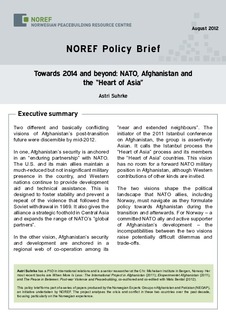Towards 2014 and beyond: NATO, Afghanistan and the "Heart of Asia"
Research report
Permanent lenke
http://hdl.handle.net/11250/2474786Utgivelsesdato
2012-09-14Metadata
Vis full innførselSamlinger
- Publications [1488]
Originalversjon
Oslo: Noref (Noref Policy Brief no. August 2012) 8 p.Sammendrag
Two different and basically conflicting visions of Afghanistan’s post-transition future were discernible by mid-2012. In one, Afghanistan’s security is anchored in an “enduring partnership” with NATO. The U.S. and its main allies maintain a much-reduced but not insignificant military presence in the country, and Western nations continue to provide development aid and technical assistance. This is designed to foster stability and prevent a repeat of the violence that followed the Soviet withdrawal in 1989. It also gives the alliance a strategic foothold in Central Asia and expands the range of NATO’s “global partners”. In the other vision, Afghanistan’s security and development are anchored in a regional web of co-operation among Afghanistan’s “near and extended neighbours”. Initiator of the 2011 Istanbul conference on Afghanistan, the group is assertively Asian. It calls the Istanbul process the “Heart of Asia” process and its members the “Heart of Asia” countries. This vision has no room for a forward NATO military position in Afghanistan, although Western contributions of other kinds are invited. The two visions shape the political landscape that NATO allies, including Norway, must navigate as they formulate policy towards Afghanistan during the transition and afterwards. For Norway – a committed NATO ally and active supporter of Afghanistan’s development – the incompatibilities between the two visions raise potentially difficult dilemmas and trade-offs.
